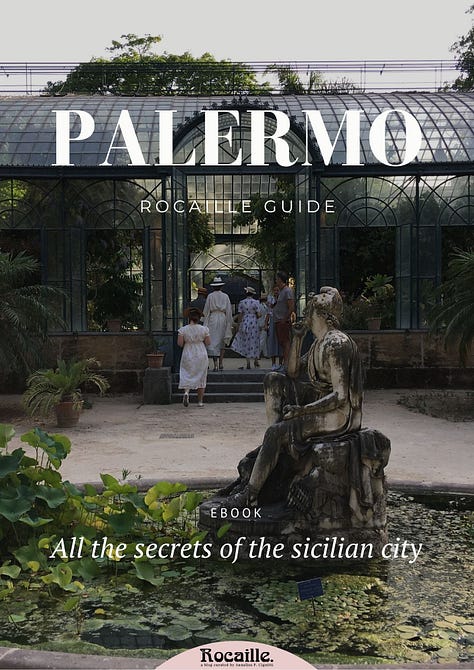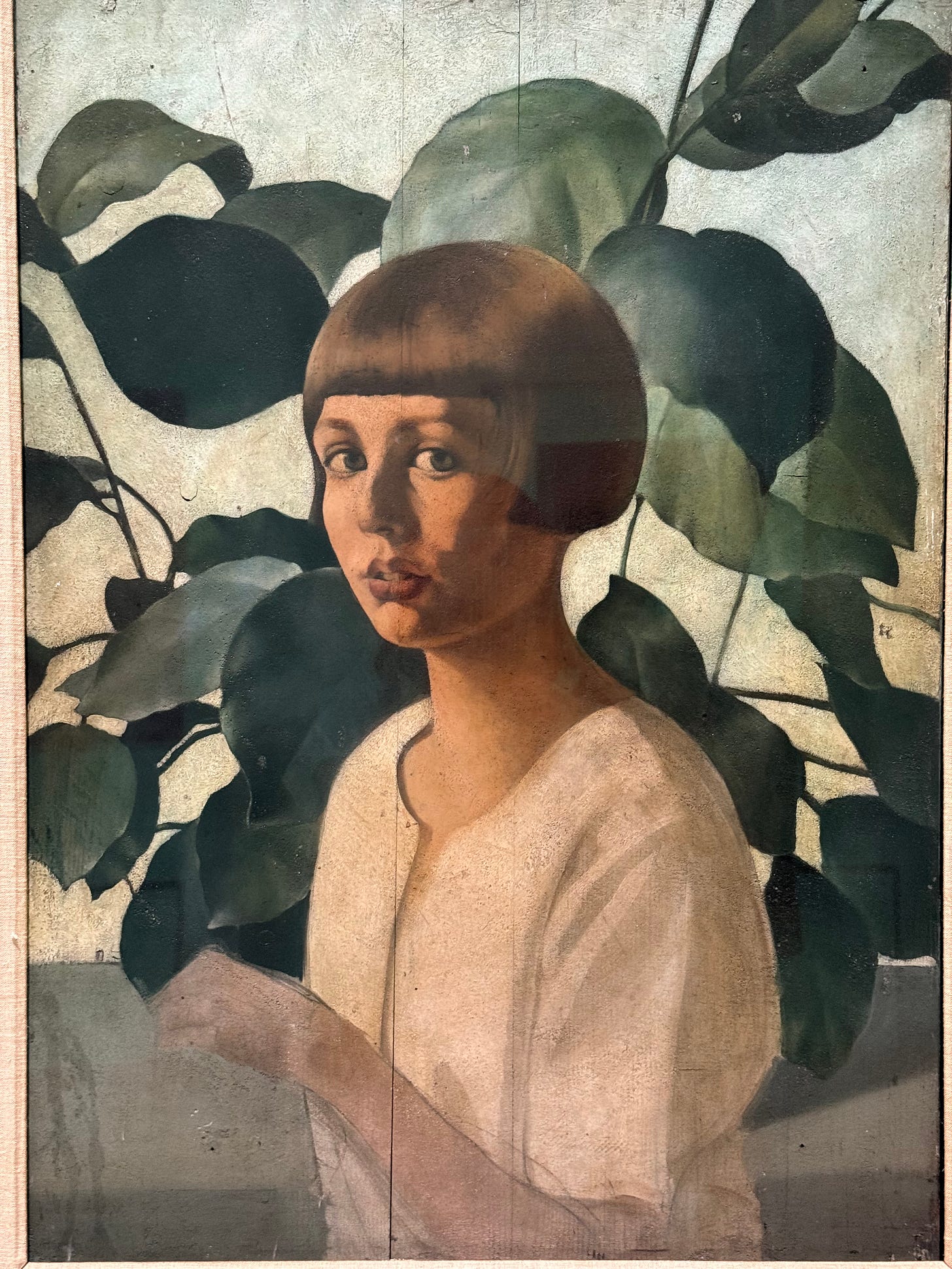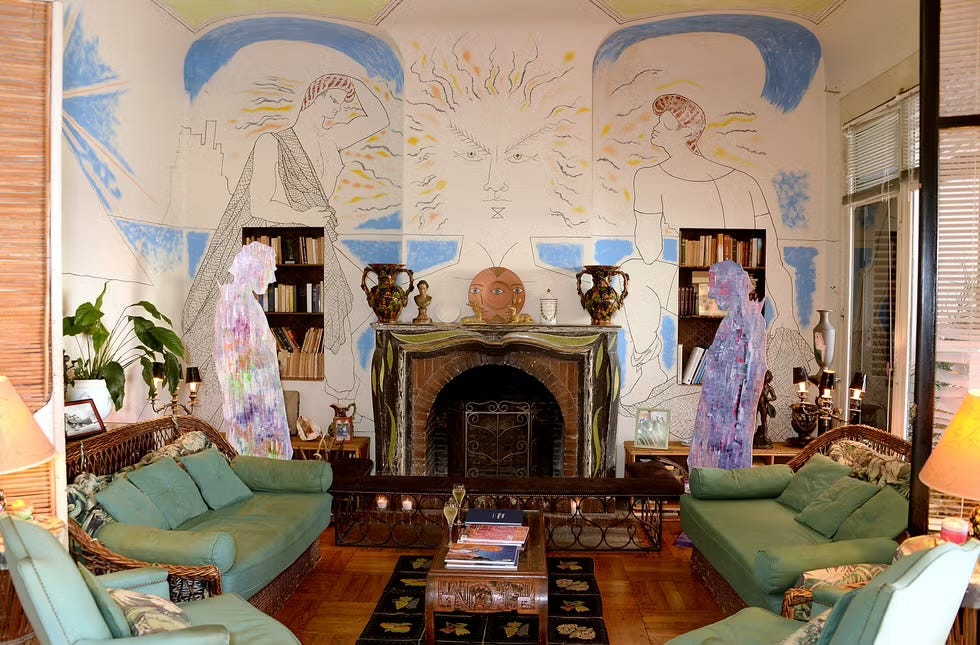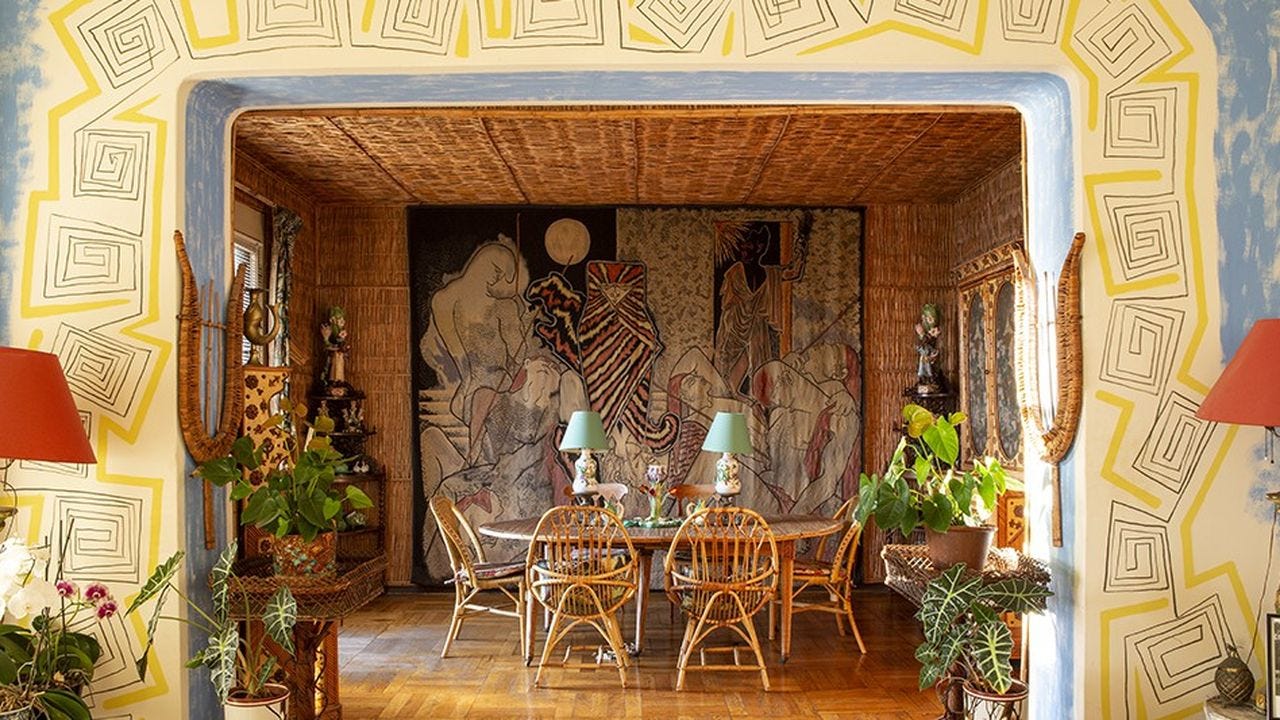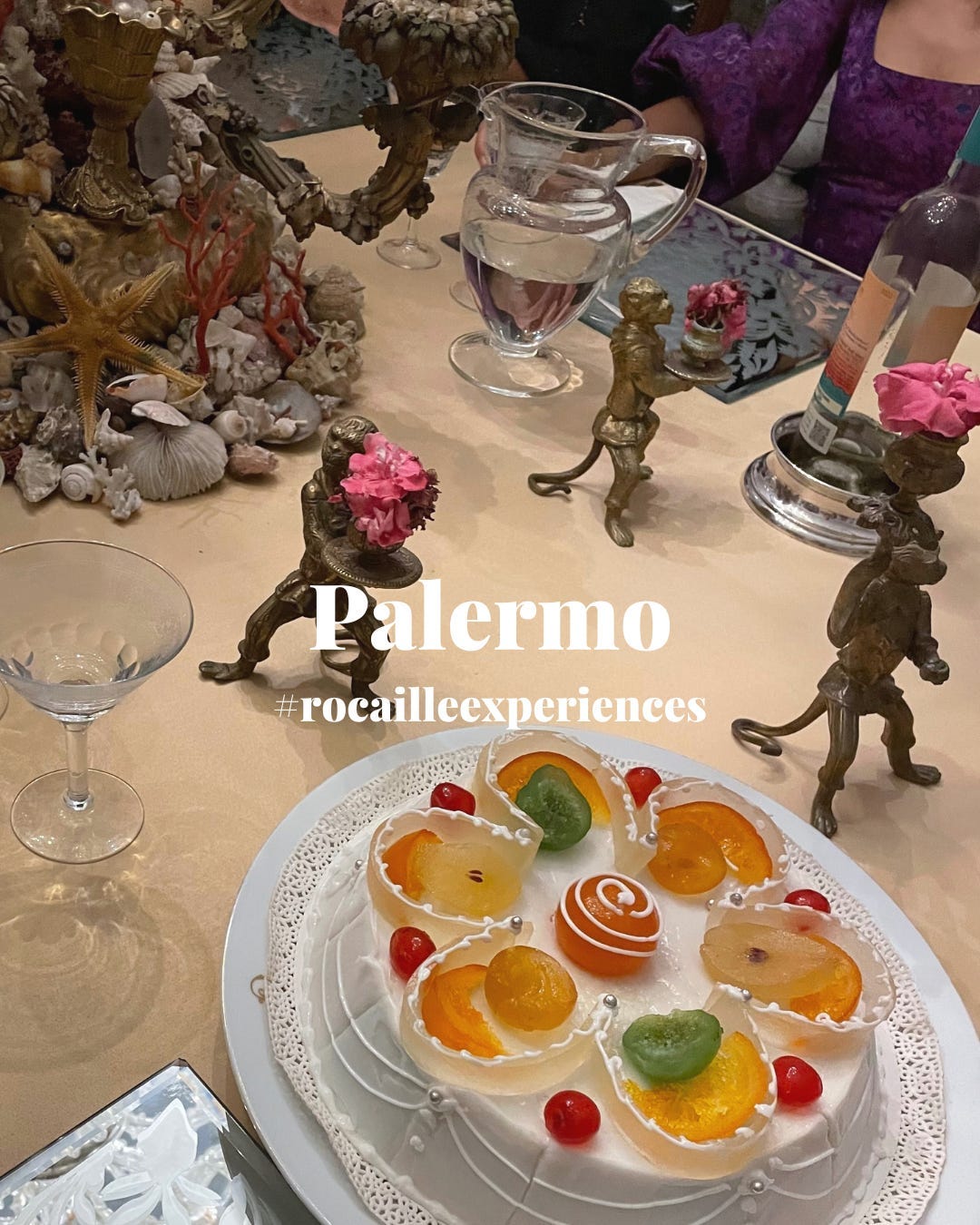#44 Rocaille Newsletter | Chi ha paura dell’estate?
Il sole nero del Mediterraneo: dalla casa di De Chirico a Roma a quella di Cocteau in Costa Azzurra
Questa è la newsletter gratuita di rocaille.it. La invio ogni mese, se non volete più riceverla potete cancellarvi dal link in fondo, se invece volete passare alla versione a pagamento potete farlo cliccando qui.
This is rocaille.it's free newsletter, I send it every month, if you no longer want to receive it you can unsubscribe from the link at the bottom. If you would like to upgrade to the paid version, you can do so by clicking here.
Vi scrivo mentre sono nel mio piccolo paradiso in Cilento, dove vengo ogni anno in estate. Questo ritratto infantile, che ho visto il mese scorso alla mostra di Felice Casorati a Palazzo Reale a Milano, mi ha fatto pensare all’estate. Lo sguardo così intenso, il “verde mestamente pertinace tra le foglie”, il non finito del braccio, tutto mi ha dato la sensazione di un’estate svanita, malinconica.
Il tema di questa newsletter è la paura dell’estate. A seguire troverete la consueta selezione di notizie tra mostre, articoli, novità e altre cose che succedono in questo mondo. Poi ci sono i miei eventi, viaggi e ebook.
Le newsletter dei mesi precedenti potete leggerle nell’archivio.
La newsletter a pagamento del mese, che arriverà il 15 luglio, sarà una Guida definitiva alla Tuscia, con informazioni che non ho pubblicato né sul blog né sui social, in basso potete vedere l’anteprima. Potete abbonarvi facendo una donazione minima di 30€ qui (è valida un anno).
Sono uscite le date dell’Experience a Palermo: 11/12/13 ottobre, più in basso trovate tutti i dettagli; di quella in Tuscia ho pubblicato le foto più belle sul mio Instagram qui). Questa è l’ultima newsletter prima dei mesi estivi. Per luglio e agosto riceverete la newsletter ma senza editoriale, per poi tornare a pieno ritmo a settembre (quella a pagamento invece continua regolarmente).
Dopo questa settimana di mare non ho altri programmi, almeno per ora, ma andrò ad Amsterdam a inizio agosto (non ci sono mai stata, se avete qualche consiglio scrivetemi). Buona estate!
Who is afraid of summer?
The black sun of the Mediterranean: from De Chirico's house in Rome to Cocteau's house on the French Riviera
I am writing to you while in my little paradise in Cilento, where I come every year in the summer. This child portrait, which I saw last month at Felice Casorati's exhibition at the Palazzo Reale in Milan, made me think of summer. The gaze so intense, the “sadly pertinacious green among the leaves,” the unfinished arm, all gave me the feeling of a vanished, melancholy summer.
The theme of this newsletter is the fear of summer. Next you will find the usual selection of news including exhibitions, articles, news and other things going on in this world. Then there are my events, travels and ebooks. Previous months' newsletters you can read in the archive.
This month's paid newsletter, coming July 14, will be a Ultimate Guide to Tuscia, with information that I have not published either on the blog or on social, below you can see the preview. You can subscribe by making a minimum donation of 30€ here (it is valid for one year).
The dates for the Experience in Palermo are out: October 11/12/13, more details below; of the one in Tuscia I posted the most beautiful photos on my Instagram here). This is the last newsletter before the summer months. For July and August you will receive the newsletter but without editorial, and then it will be back in full swing in September (the paid one, on the other hand, continues regularly).
After this beach week I have no other plans, at least for now, but I am going to Amsterdam in early August (I have never been there, if you have any advice write to me). Have a great summer!
Chi ha paura dell’estate?
Era il luglio del 1973 quando Giorgio de Chirico (1888 – 1978), all’epoca ottantacinquenne, intervistato da Franco Simongini rispondeva a varie domande sulla sua pittura. Era per un documentario della Rai (che potete vedere qui), l’ambientazione è quella della casa-studio di Piazza di Spagna a Roma, dove l’artista ha vissuto gli ultimi trent’anni della sua vita, oggi museo.
Mentre parla De Chirico sta dipingendo un’opera caratteristica della Neometafisica: Sole sul cavalletto, un tema che appare per la prima volta nelle litografie eseguite per i Calligrammes di Apollinaire nel 1930 e che riprende negli anni ‘70, come fece con molti altri suoi temi.
“È un soggetto che riguarda i soli, il sole spento in cielo e che si riaccende in una camera”, racconta mentre completa il disegno sulla tela bianca. La chiacchierata continua in modo molto divertente, a domande elementari l’artista risponde con grandi verità dette in modo semplice, il tutto mentre completa il disegno e poi colora prima il cielo di verde-blu e poi gli astri. Nel cielo il sole e la luna appaiono neri, in netto contrasto con i loro omologhi in primo piano che colora di giallo, collegati tra di loro con un filo.
It was July 1973 when Giorgio de Chirico (1888 - 1978), then 85 years old, was interviewed by Franco Simongini answering various questions about his painting. It was for a Rai documentary (which you can watch here), the setting being the home-studio in Rome's Piazza di Spagna, where the artist lived the last 30 years of his life, now a museum.
As he speaks, De Chirico is painting a work characteristic of Neometaphysics: Sun on the Easel, a theme that first appeared in the lithographs he executed for Apollinaire's Calligrammes in 1930 and which he took up again in the 1970s, as he did with many of his other themes.
“It's a subject about suns, the sun extinguished in the sky and rekindled in a room,” he says as he completes the drawing on the blank canvas. The chat continues in a very entertaining way, to elementary questions the artist answers with great truths told in a simple way, all while completing the drawing and then coloring first the sky green-blue and then the stars. In the sky the sun and moon appear black, in stark contrast to their counterparts in the foreground, which he colors yellow, connected by a thread.
Il giornalista gli chiede : “lei non ama le giornate di sole pieno, caldo?”, lui risponde: “No, mi piacciono le giornate buie, quando piove, col cielo coperto.”
Non credo che De Chirico avesse paura dell’estate ma di certo non l’amava. E nel dipinto toglie il sole e la luna dal cielo per trasportarli dentro casa. Quel sole nel cielo non lo può vedere, lo annerisce e lo porta sul suo cavalletto. Più avanti, nella stessa intervista, dice di non amare neanche la campagna perché gli mette tristezza e preferisce la città, con le persone e le macchine. Ad una dimensione naturale preferisce la ricostruzione artificiale. Alla realtà la pittura.
De Chirico era nato in Grecia, da genitori italiani (suo padre era siciliano). Ha in sé una parte radicalmente mediterranea che è, per essenza, una cultura solare. Trascorre qualche anno della sua formazione a Monaco di Baviera, uno dei maggiori centri della cultura figurativa europea. Qui frequenta i corsi di bianco e nero e di pittura all'Accademia di belle arti e viene a contatto con la pittura romantica e artisti come i nazareni, Hans von Marées e Adolph von Menzel. Poi Arnold Böcklin, che ama per il senso di turbamento e di sorpresa e la capacità di rivisitare e far rivivere l'antichità, ma soprattutto Max Klinger, per gli accostamenti imprevedibili e le situazioni paradossali. Si crea in lui un corto circuito: da un lato la sua natura profonda di uomo mediterraneo e classico ma dall’altro una visione nordica e romantica della realtà, che diventa distaccata e fredda, misteriosa.
The reporter asks him : “don't you like full, hot, sunny days?” he replies, “No, I like dark days, when it rains, with an overcast sky. ”I don't think De Chirico was afraid of summer but he certainly didn't love it. And in the painting he takes the sun and moon out of the sky and transports them inside the house. That sun in the sky he cannot see, he blackens it and carries it to his easel. Later, in the same interview, he says he does not even like the countryside because it makes him sad and he prefers the city, with people and cars. To a natural dimension he prefers artificial reconstruction. To reality, painting.
De Chirico was born in Greece, to Italian parents (his father was Sicilian). He has in him a radically Mediterranean part that is, by essence, a solar culture. He spent a few years of his training in Munich, one of the major centers of European figurative culture. Here he took courses in black and white and painting at the Academy of Fine Arts and came into contact with Romantic painting and artists such as the Nazarenes, Hans von Marées and Adolph von Menzel. Then Arnold Böcklin, whom he loves for his sense of disturbance and surprise and his ability to revisit and revive antiquity, but especially Max Klinger, for his unpredictable juxtapositions and paradoxical situations. A short circuit is created in him: on the one hand his deep nature as a Mediterranean and classical man but on the other hand a Nordic and romantic view of reality, which becomes detached and cold, mysterious.
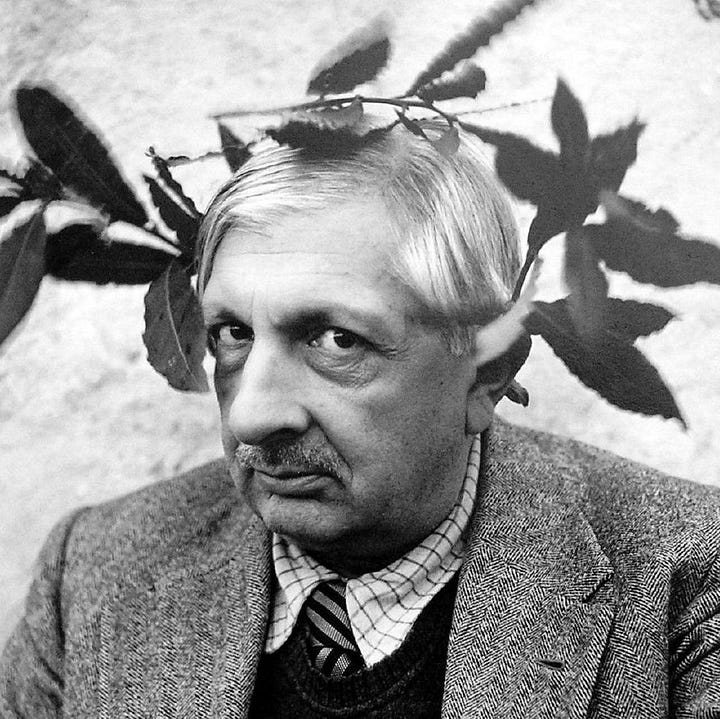
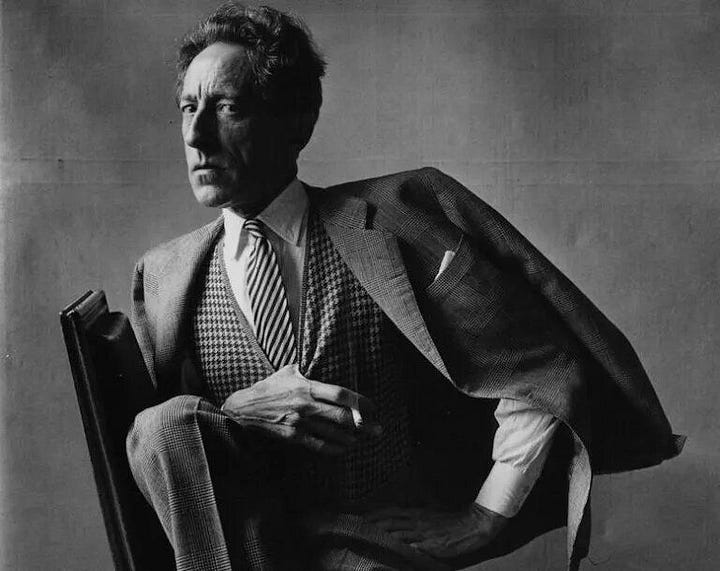
Siamo in estate, a molti piace stare al sole, sentire il caldo. E’ normale trarre un piacere da questo e io stessa non ne sono esente eppure sento di capire de Chirico. Capisco chi vuole fuggire, chi odia il sole e il caldo e preferisce rintanarsi in casa e aspettare il ritorno dell’inverno. Non sempre il sole è un simbolo di positività, spesso anzi nasconde molto più che rivelare. Come diceva Goethe “Dove c’è molta luce, l’ombra è più nera”.
Jean Cocteau (1889 – 1963), nella sua poesia Batterie, scrive una vera e propria preghiera al sole, gli chiede di cancellare il suo dolore:
SOLEIL je t'adore comme les sauvages plat ventre sur le rivage
Soleil tu vernis tes chromos tes paniers de fruits, tes animaux
Fais-moi le corps tanne, sale, fais ma grande douleur s'en aller
Sole, Ti adoro come i selvaggi sulla riva
Sole che dipingi i tuoi cromosomi i tuoi cesti di frutta, i tuoi animali
Rendi il mio corpo abbronzato, sporco, fai sparire il mio grande dolore
We are in summer, many people like to be in the sun, to feel the heat. It is normal to derive pleasure from this and I myself am not exempt from it, and yet I feel I understand de Chirico. I understand those who want to escape, those who hate the sun and the heat and prefer to hole up indoors and wait for winter to return. The sun is not always a symbol of positivity, often indeed it hides much more than it reveals. As Goethe said, “Where there is much light, the shadow is blackest.”
Jean Cocteau (1889 - 1963), in his poem Batterie, writes a real prayer to the sun, asking it to erase his pain:
SUN I adore you like the savages flat on the shore
Sun you varnish your chromos your fruit baskets, your animals
Make my body tanned, dirty, make my great pain go away
Anche Cocteau ama il Mediterraneo, però quello meno violento della Costa Azzurra, che frequenta spesso sin dagli anni ‘30. Nel 1950, durante le riprese del film "Les Enfants Terribles", tratto da un suo lavoro teatrale, conosce Francine Weisweiller, proprietaria della casa parigina dove stanno girando alcune scene. Diventano subito amici e Francine lo invita, insieme al compagno Édouard Dermit, a passare qualche giorno di vacanza nella sua villa in Costa Azzurra.
Situata in una posizione panoramica sul Mediterraneo, Villa Santo Sospir si trova a Saint-Jean-Cap-Ferrat, sulla strada verso il faro che domina tutta la baia di Villefranche-sur-Mer. Quelle che dovevano essere solo poche settimane diventano più di dieci anni di frequentazione. Pochi giorni dopo il suo arrivo, dopo essersi riposato dalle fatiche del set, Cocteau comincia ad annoiarsi. «Questo ozio mi stanca, mi sento appassire», confida alla sua ospite. Le chiede il permesso di disegnare sulle pareti della villa e Francine acconsente.
Cocteau also loves the Mediterranean, however, the less violent one of the Côte d'Azur, which he has been frequenting since the 1930s. In 1950, during the filming of “Les Enfants Terribles,” based on one of his plays, he met Francine Weisweiller, owner of the Parisian house where they were shooting some scenes. They immediately became friends, and Francine invited him, along with his partner Édouard Dermit, to spend a few days of vacation at her villa on the French Riviera.
Situated in a panoramic position on the Mediterranean, Villa Santo Sospir is located in Saint-Jean-Cap-Ferrat, on the way to the lighthouse overlooking the entire bay of Villefranche-sur-Mer. What was supposed to be only a few weeks became more than a decade of attendance. A few days after arriving, having rested from the labors of the set, Cocteau began to grow bored. “This idleness tires me, I feel withering,” he confides to his hostess. He asks her permission to draw on the walls of the villa, and Francine agrees.
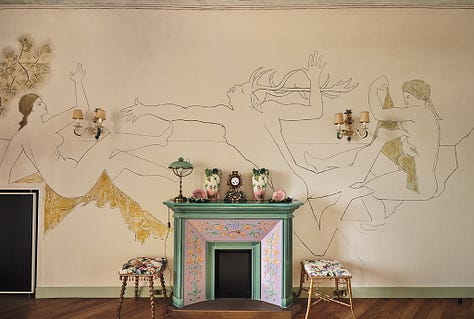
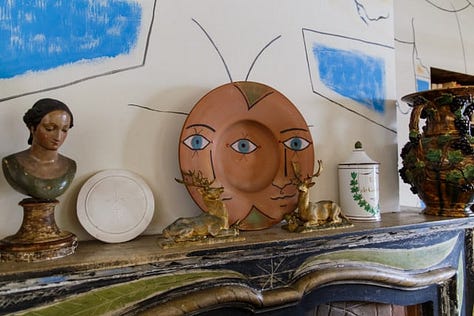
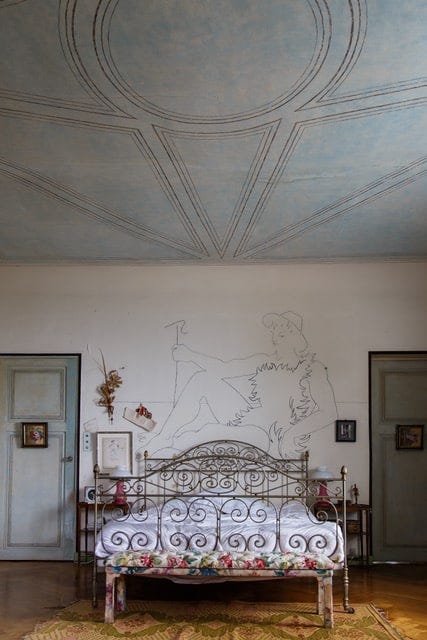


La prima immagine che Cocteau dipinge, direttamente sulla parete, è un volto maschile a forma di sole. Rappresenta Apollo, il dio Sole, patrono e artefice della musica, della poesia e dell'arte. “Non ho dovuto vestire le pareti. Ho dovuto dipingere sulla loro pelle”. Cocteau inizia a creare figure a carboncino, lavorando a mano libera direttamente sulle pareti. Crea, disegno dopo disegno, una villa popolata di ritratti di dei, ninfe e pescatori, una decorazione perpetua che si sviluppa da una stanza all'altra. In pochi mesi, l'intera villa è ricoperta di figure che Cocteau chiama "tatuaggi".
Tornerà alla villa ogni estate, per i dodici anni successivi e girerà un film sulla tenuta, "La Villa Santo-Sospir" e a Santo Sospir verrà realizzata la maggior parte delle sue interviste televisive. Inoltre, alla villa verrà ambientato il suo film Le Testament d'Orphée (Ne me demandez pas pourquoi).
The first image Cocteau paints, directly on the wall, is a sun-shaped male face. He represents Apollo, the Sun god, patron and creator of music, poetry and art. "I didn't have to dress the walls. I had to paint on their skin." Cocteau begins to create figures in charcoal, working freehand directly on the walls. He created, drawing after drawing, a villa populated with portraits of gods, nymphs and fishermen, a perpetual decoration that spread from room to room. In just a few months, the entire villa is covered with figures that Cocteau calls “tattoos”.He will return to the villa every summer for the next twelve years and make a film about the estate, “La Villa Santo-Sospir,” and most of his television interviews will be conducted at Santo Sospir. In addition, his film Le Testament d'Orphée (Ne me demandez pas pourquoi) will be set at the villa.
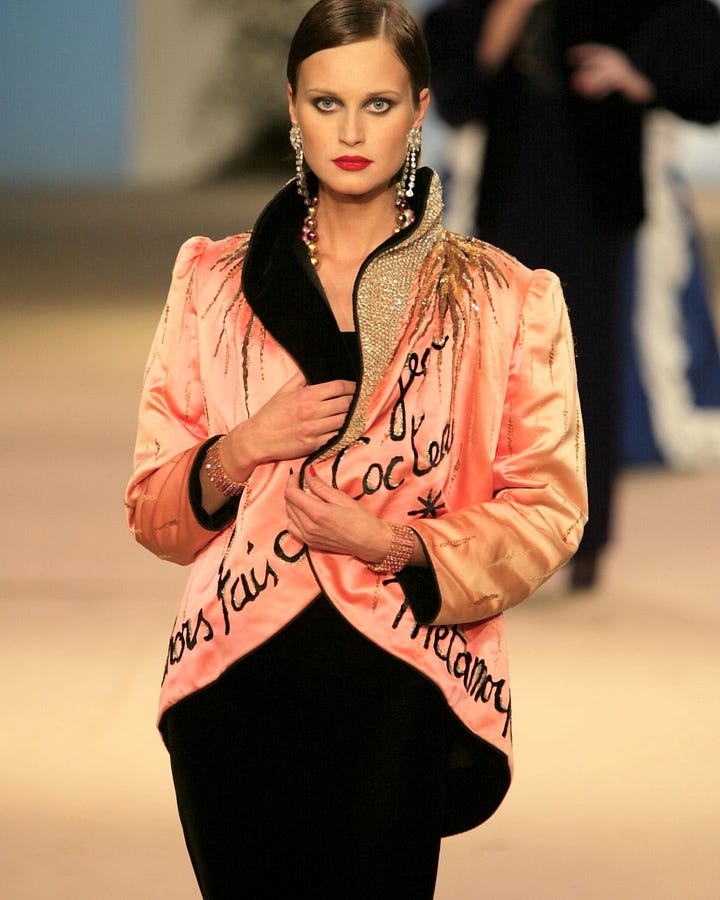

Ma il sole che disegna Cocteau non è così spensierato. Quelle scene rappresentano un idillio, uno stato di grazia della vita che si può sognare, ma non esiste. Cocteau non era mai venuto fuori definitamente dalla sua dipendenza da oppio, in cui era caduto in seguito alla morte del suo compagno, il poeta Raymond Radiguet.
La poesia Batterie, che appare come un inno euforico e gioioso, in realtà nasconde un tono cupo. Il poeta continua con un’altra richiesta, compiere una metamorfosi: se i neri sono neri fuori ma rosa dentro, ecco che lui vorrebbe il contrario, perché interiormente si sente nero più che mai.
Le nègre dont brillent les dents est noir dehors, rose dedans
Moi je suis noir dedans et rose dehors, fais la metamorphose
Il negro con i denti lucidi è nero fuori e rosa dentro
Io invece sono nero dentro e rosa fuori, fai una metamorfosi
But the sun that Cocteau draws is not so carefree. Those scenes represent an idyll, a state of life's grace that can be dreamed of but does not exist. Cocteau had never definitively come out of his opium addiction, into which he had fallen following the death of his partner, the poet Raymond Radiguet. The poem Batterie, which appears to be a euphoric and joyful hymn, actually conceals a somber tone. The poet continues with another request, to perform a metamorphosis: if black people are black on the outside but pink on the inside, here he would like the opposite, because inwardly he feels blacker than ever.
The negro whose teeth shine is black outside, pink inside
I am black inside and pink outside, make the metamorphosis
What shall I do when the Summer troubles—
What, when the Rose is ripe—
What when the Eggs fly off in Music
From the Maple Keep?
Emily Dickinson
News, events, exhibitions, articles
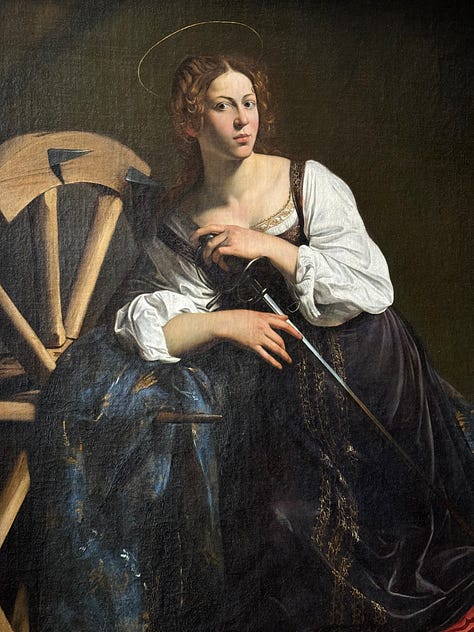
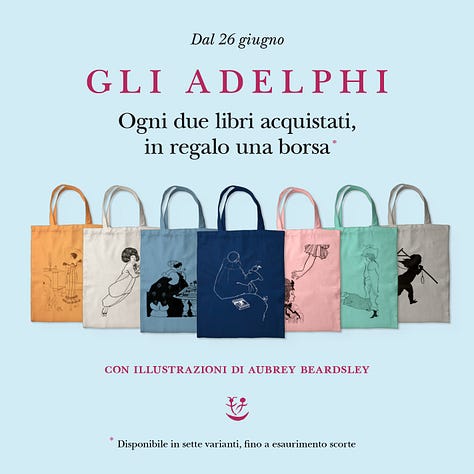

Da giovedì 26 giugno, ogni due libri acquistati della collana dei tascabili “Gli Adelphi”, una borsa con illustrazioni di Aubrey Beardsley in omaggio!
E’ in arrivo un film sulla vita della pittrice surrealista Leonora Carrington.
ROMA
Avevo desistito dal visitare la mostra “Caravaggio 2025” a Palazzo Barberini, causa fila e ressa continua. Ho avuto poi la fortuna di visitarla insieme al direttore Thomas Clement Salomon e non si può non riconoscere che sia una mostra importantissima. Non solo per il successo di pubblico, nell’anno del Giubileo, ma anche perché rende possibile vedere ben 24 opere di Caravaggio tutte insieme. Tra queste alcune sono difficili da vedere perché sparse in vari musei per il mondo come I Musici dal MET di NY o I Bari dal Texas o in collezioni private come la Conversione di Saulo su legno, proveniente dalla collezione privata degli Odescalchi (uno dei pochissimi ancora in mano privata). Altre opere non si vedevano in Italia da secoli come l’Ecce Homo, scoperto da poco in Spagna, o L’Estasi di Santa Caterina da Madrid.
Con l’occasione il direttore mi ha anche mostrato la collocazione nel Salone Pietro da Cortona dei cartoni preparatori del ciclo de ‘La Vita di Urbano VIII’, cerchia di Pietro da Cortona, ricostruendo la funzione del salone come luogo di rappresentazione della dinastia Barberini. Un’ottima idea per un museo che con la nuova direzione ha avuto una evidente e importante riqualificazione.
La mostra è stata prorogata fino al 20 luglio!Ha aperto il nuovo spazio della Fondazione Valentino Garavani e Giancarlo Giammetti: PM23, in piazza Mignanelli, tra arte, moda e memoria condivisa. Ora è in mostra una selezione di abiti in rosso, fino al 31 agosto.
E’ stata restaurata e da poco aperta al pubblico la torre belvedere di Palazzo Altemps con decorazioni e affreschi databili tra il tardo Cinquecento e un periodo racchiuso tra il 1830 e l’inizio del Novecento.
Grazie all’investimento della direttrice creativa di Dior Maria Grazia Chiuri, è stato riaperto il Teatro della Cometa, voluto dalla contessa Pecci Blunt, che aveva affidato il progetto all’architetto Tommaso Buzzi. Acquistato nel 2020 e restaurato ora lo spazio rivive come centro di produzione teatrale e artistica aperto alla città.
A 50 anni dalla scomparsa di Antonietta Raphaël e 60 da quella di Mario Mafai, Villa Torlonia dedica alla coppia di artisti del Novecento una grande mostra ricca di ritratti (anche inediti) che raccontano il loro rapporto ben oltre il sodalizio artistico.
Palazzo San Felice, dirimpetto al Quirinale, sarà la nuova sede della Biblioteca di Archeologia e Storia dell’Arte (BIASA) progettata da Mario Botta e ora ospitata a Palazzo Venezia. Pronto all’inizio del 2027, intanto Palazzo San Felice apre al pubblico, tra tesori antichi, vita di cantiere ed esperienze digitali.
La Fondazione Bvlgari avvia una collaborazione pluriennale con il Museo Nazionale Etrusco di Villa Giulia. Curerà il relamping di tre sale e inizia con la mostra sull’arte orafa a cavallo tra Ottocento e Novecento, in relazione ai gioielli etruschi.
La Cy Twombly Foundation ha donato dodici opere ( di qui undici lavori di Cy Twombly e un’opera di Pablo Picasso) dal valore complessivo di 39,5 milioni di dollari (circa 33,7 milioni di euro) alla Galleria Nazionale d’Arte Moderna e Contemporanea!
- From Thursday, June 26, for every two books purchased in the “Gli Adelphi” paperback series, a free bag with illustrations by Aubrey Beardsley!
- A film about the life of surrealist painter Leonora Carrington is coming soon.
ROMA
- I had desisted from visiting the exhibition “Caravaggio 2025” at Palazzo Barberini, due to continuous lines and crowds. I was then fortunate enough to visit it together with director Thomas Clement Salomon, and one cannot help but recognize that it is a very important exhibition. Not only because of the success of the public, in the Jubilee year, but also because it makes it possible to see as many as 24 works by Caravaggio all together. Among them some are difficult to see because they are scattered in various museums around the world such as The Musicians from the MET in NY or The Bari from Texas or in private collections such as the Conversion of Saul on wood from the Odescalchi private collection (one of the very few still in private hands). Other works had not been seen in Italy for centuries such as Ecce Homo, recently discovered in Spain, or The Ecstasy of St. Catherine from Madrid. With the occasion, the director also showed me the placement in the Pietro da Cortona Hall of the preparatory cartoons for the cycle of ‘The Life of Urban VIII,’ Pietro da Cortona's circle, reconstructing the hall's function as a place of representation of the Barberini dynasty. An excellent idea for a museum that has had an obvious and important redevelopment under the new direction. The exhibition has been extended until July 20!
- The Valentino Garavani and Giancarlo Giammetti Foundation's new space has opened: PM23, in Piazza Mignanelli, between art, fashion and shared memory. A selection of dresses in red is now on display until August 31.
- The belvedere tower of Palazzo Altemps, with decorations and frescoes dating from the late 16th century to a period enclosed between 1830 and the early 20th century, has been restored and recently opened to the public.
- Thanks to the investment of Dior creative director Maria Grazia Chiuri, the Teatro della Cometa, wanted by Countess Pecci Blunt, who had entrusted the project to architect Tommaso Buzzi, was reopened. Purchased in 2020 and restored now the space revives as a center of theatrical and artistic production open to the city.
- Fifty years after the death of Antonietta Raphaël and 60 years after that of Mario Mafai, Villa Torlonia is dedicating a major exhibition to the pair of twentieth-century artists, full of portraits (some previously unpublished) that tell of their relationship far beyond their artistic partnership.
- Palazzo San Felice, opposite the Quirinale, will be the new home of the Library of Archaeology and Art History (BIASA) designed by Mario Botta and now housed in Palazzo Venezia. Ready in early 2027, meanwhile, Palazzo San Felice opens to the public, amid ancient treasures, site life and digital experiences.
- The Bvlgari Foundation begins a multi-year collaboration with the National Etruscan Museum of Villa Giulia. It will curate the relamping of three rooms and begins with an exhibition on goldsmith art at the turn of the 19th and 20th centuries in relation to Etruscan jewelry.
- The Cy Twombly Foundation donated twelve works ( here eleven works by Cy Twombly and one work by Pablo Picasso) with a total value of $39.5 million (about 33.7 million euros) to the National Gallery of Modern and Contemporary Art!ITALIA
VENEZIA Sono esposti a Ca’ Pesaro i pannelli che Giulio Aristide Sartorio realizzò nel 1907 per il Salone centrale dell’Esposizione internazionale. Fino al 28 settembre.
NAPOLI In occasione dell’estate riaprono al pubblico importanti siti archeologici come la monumentale Piscina Mirabilis, le Cento Camerelle e le austere prigioni del Castello di Baia nel Parco dei Campi Flegrei.
VENETO Dopo tre anni di restauro riapre il Giardino di Pojega, un elegante giardino settecentesco all’italiana, con tanto di villa e teatro di verzura.
EMILIA ROMAGNA Al Labirinto della Masone è in mostra il visionario universo di Luigi Serafini, ospitato nel museo dell’editore che per primo pubblicò il suo enigmatico Codex Seraphinianus nel 1981. Fino al 13 luglio.
LIGURIA Mark Dion in mostra a Genova, apre con un’installazione che evoca lo studio di un entomologo Anni Cinquanta, malinconico e disilluso. Il tema è una riflessione sulle minacce di scomparsa che incombono su molte specie animali.
LIGURIA Riapre Villa Rezzola a Lerici, tra i più bei giardini inglesi della Riviera di Levante, con un sistema di viali, fontane, belvedere, agrumi e piante esotiche.
TOSCANA Nel Chianti torna la biennale Arte nel Paesaggio.
LAZIO Ha riaperto alla Villa d’Este di Tivoli La Grotta di Diana, grazie al supporto di Fendi.
MONDO
PARIGI Al Palais Galliera apre la prima monumentale retrospettiva dedicata allo stilista californiano Rick Owens. Temple of Love. Fino al 4 gennaio 2026
PARIGI Al Musée des Arts Décoratifs è in corso la prima grande mostra dedicata a Paul Poiret, stilista ma anche scrittore, musicista e pittore di inizio ’900 . Fino all’11 gennaio.
BARCELLONA Hanno restaurato i colori originali della facciata posteriore e del cortile interno della celebre Casa Batlló di Antoni Gaudì, svelando il progetto originale del 1906. Prima o poi la vedrò!
SVIZZERA Ad Ascona, in occasione dei 100 anni dalla morte di Félix Valloton, il museo del Castello san Materno ha ideato una mostra. Fino al 7 settembre.
ITALY
- VENEZIA Sono esposti a Ca’ Pesaro i pannelli che Giulio Aristide Sartorio realizzò nel 1907 per il Salone centrale dell’Esposizione internazionale. Fino al 28 settembre.
- NAPOLI In occasione dell’estate riaprono al pubblico importanti siti archeologici come la monumentale Piscina Mirabilis, le Cento Camerelle e le austere prigioni del Castello di Baia nel Parco dei Campi Flegrei.
- VENETO Dopo tre anni di restauro riapre il Giardino di Pojega, un elegante giardino settecentesco all’italiana, con tanto di villa e teatro di verzura.
- EMILIA ROMAGNA Al Labirinto della Masone è in mostra il visionario universo di Luigi Serafini, ospitato nel museo dell’editore che per primo pubblicò il suo enigmatico Codex Seraphinianus nel 1981. Fino al 13 luglio.
- LIGURIA Mark Dion in mostra a Genova, apre con un’installazione che evoca lo studio di un entomologo Anni Cinquanta, malinconico e disilluso. Il tema è una riflessione sulle minacce di scomparsa che incombono su molte specie animali.
- LIGURIA Riapre Villa Rezzola a Lerici, tra i più bei giardini inglesi della Riviera di Levante, con un sistema di viali, fontane, belvedere, agrumi e piante esotiche.
- TOSCANA Nel Chianti torna la biennale Arte nel Paesaggio.
- LAZIO Ha riaperto alla Villa d’Este di Tivoli La Grotta di Diana, grazie al supporto di Fendi.
WORLDWIDE
- PARIS At the Palais Galliera opens the first monumental retrospective devoted to California designer Rick Owens. Temple of Love. Through Jan. 4, 2026
- PARIS At the Musée des Arts Décoratifs the first major exhibition dedicated to Paul Poiret, a fashion designer but also a writer, musician and painter of the early 20th century . Through Jan. 11.
- BARCELONA They have restored the original colors of the rear facade and inner courtyard of Antoni Gaudi's famous Casa Batlló, revealing the original 1906 design. I'm going to see it sooner or later!
- SWITZERLAND In Ascona, on the occasion of the 100th anniversary of Félix Valloton's death, the San Materno Castle Museum has designed an exhibition. Through Sept. 7.
Rocaille Experience:
La Bella Palermo III: 11/12/13 October 2025
Un viaggio di 3 giorni e 2 notti alla scoperta di Palermo, città in cui è possibile incontrare nobili eccentrici e fané, residenze avite magnifiche e in rovina; natura violenta e dolcissimi frutti. Splendore e miseria. Di nuovo ad ottobre e di nuovo in collaborazione con La Bella Palermo. Qui, nel grande salone, avremo la possibilità esclusiva di fare una serata “Pizza chic”: sarà un’occasione per presentarci e conoscerci meglio prima di partire per l’esplorazione.
Il programma prevede sempre la visita prevede anche la visita di luoghi storici: musei, castelli, giardini segreti, ville, residenze d’artista. Si tratta sempre di luoghi fuori dalle rotte del turismo di massa e che raccontano storie e realtà spesso poco conosciute. Nel tempo libero proporrò altre visite e attività, che ognuno è libero di seguire o no ma, in ogni caso, sarò sempre a disposizione per suggerimenti o consigli.
DOVE ALLOGGEREMO?
Avremo a disposizione la possibilità di alloggiare per due notti in quello che è il più bell'appartamento della città: La Bella Palermo. Occupa tutto il piano nobile di Palazzo Pantelleria, proprio nel cuore del centro storico (piazza Largo dei Cavalieri di Malta, dietro la chiesa di San Domenico), 1000 metri quadri con 3 saloni, 5 stanze da letto e un terrazzo, affacciato sul cortile interno del palazzo, dominato da un ficus-magnolide secolare. Il proprietario, l’architetto Massimo Cazzaniga, classe 1940, lo ha comprato nel 2002 quando era praticamente fatiscente, lo ha ristrutturato e lo ha decorato secondo il suo gusto raffinato ed eclettico. Se scorrete in basso potete vedere qualche foto, altrimenti potete leggere la sua storia sul mio blog qui.
Potrete soggiornare in questo magnifico appartamento, per le notti del 11 e 12 ottobre, a queste condizioni:
L’appartamento può ospitare solo 8 persone. L’appartamento è enorme, i saloni sono di uso comune ma ognuno ha la sua camera e il suo bagno (ce ne sono 5) quindi tutti hanno la possibilità di godere della propria privacy. Potete vedere esattamente la disposizione delle stanze qui;
L’appartamento ha 2 camere singole e 3 matrimoniali, che devono essere prenotate da una coppia di persone disposte a dormire insieme (i letti non sono separabili);
L’appartamento sarà confermato solo al raggiungimento delle 8 persone (si affitta solo per intero).
ATTENZIONE
L’Experience è confermata solo al raggiungimento di 8 partecipanti che alloggiano in appartamento.
E’ possibile partecipare come ospiti esterni se e solo se l’Experience è confermata.
QUANDO?
Le attività dell'Experience coprono il secondo fine settimana di ottobre: iniziano ufficialmente la sera del 11 ottobre e finiscono la mattina di lunedì 13.
QUANTO?
Ci sono 3 tipologie di quota. Prenotando dopo il 1 settembre si deve aggiungere una piccola percentuale in più:
650€ per chi alloggia nella camera singola con bagno esterno;
690€ per chi alloggia nella camera singola con bagno interno;
1300€ matrimoniale;
1300€ matrimoniale uso singola;
+10% se si prenota dopo il 1 settembre 2025;
la quota come ospite esterno sarà comunicata solo dal 1 settembre (se l’experience è confermata).
LA QUOTA COMPRENDE:
alloggio per due notti nel meraviglioso appartamento La Bella Palermo (solo per 8 persone). La formula è uso b&b quindi è compresa la prima colazione ed è concesso agli ospiti l’uso libero di tutti i saloni;
2 visite non esclusive;
cena a La Bella Palermo;
mio accompagnamento e assistenza durante tutta la durata del viaggio;
la mia Guida Rocaille di Palermo.
NON COMPRENDE: trasporti e tutto quanto non specificato.
COME PRENOTARE?
Dopo aver compilato il form qui , vi manderò le istruzioni per il pagamento.
A 3-day, 2-night voyage of discovery of Palermo, a city where you can encounter eccentric nobles and fané, magnificent and ruined ancestral residences; violent nature and sweet fruits. Splendor and misery. Again in October and again in collaboration with La Bella Palermo. Here, in the great hall, we will have the exclusive opportunity to have a “Pizza chic” evening: it will be an opportunity to introduce ourselves and get to know each other better before we leave for exploration. The program always includes visiting historical places as well: museums, castles, secret gardens, villas, artist residences. These are always places that are off the beaten path of mass tourism and tell stories and realities that are often little known. In my free time I will propose other visits and activities, which everyone is free to follow or not but, in any case, I will always be available for suggestions or advice.
WHERE WILL WE STAY?
We have the option of staying for two nights in what is the most beautiful apartment in the city: La Bella Palermo. It occupies the entire main floor of Palazzo Pantelleria, right in the heart of the historic center (Piazza Largo dei Cavalieri di Malta, behind the church of San Domenico), 1,000 square meters with 3 lounges, 5 bedrooms and a terrace, overlooking the inner courtyard of the palace, dominated by a centuries-old ficus-magnolide. The owner, architect Massimo Cazzaniga, born in 1940, bought it in 2002 when it was practically dilapidated, renovated it and decorated it according to his refined and eclectic taste. If you scroll down you can see some photos, otherwise you can read her story on my blog here.
You can stay in this magnificent apartment, for the nights of October 12 and 13, under these conditions:
- The apartment can only accommodate 8 people, so not the whole group will be able to stay there. The apartment is huge, the lounges are for common use but everyone has their own room and bathroom (there are 5) so everyone gets to enjoy their privacy. You can see exactly the layout of the rooms here;
- The apartment has 2 single and 3 double rooms, which must be booked by a couple willing to sleep together (the beds are not separable);
- The apartment will be confirmed only when the number of 8 people is reached (it is rented only in full).
ATTENTION
- The Experience is confirmed only upon reaching 8 participants staying in the apartment.
- It’s possible to participate as external guests if and only if the Experience is confirmed.
WHEN?
The Experience activities cover the second weekend of October: they officially begin on the evening of Oct. 11 and end on the morning of Monday, Oct. 13.
HOW MUCH?
There are 3 types of fees:
- 650€ for those staying in the single room with external bathroom;
- 690€ single room with private bathroom;
- 1300€ double;
- 1300€ double single use;
+10% if you book after September 1, 2025;
- the fee as an external guest will be announced only from September 1 (if the experience is confirmed).
THE FEE INCLUDES:
- accommodation for two nights in the wonderful apartment La Bella Palermo (for 8 people only). The formula is b&b use so breakfast is included and guests are allowed free use of all lounges;
- 2 non exclusive visits;
- dinner at La Bella Palermo;
- my accompaniment and assistance throughout the trip;
- my Rocaille Guide to Palermo.
DOES NOT INCLUDE: transportation and anything not specified.
HOW TO BOOK?
After filling out the form here , I will send you payment instructions and you will receive the detailed program.
PREVIEW
Exclusive newsletter - June 2025
The next exclusive newsletter will be a Ultimate Guide to Tuscia.
Out on July 15.
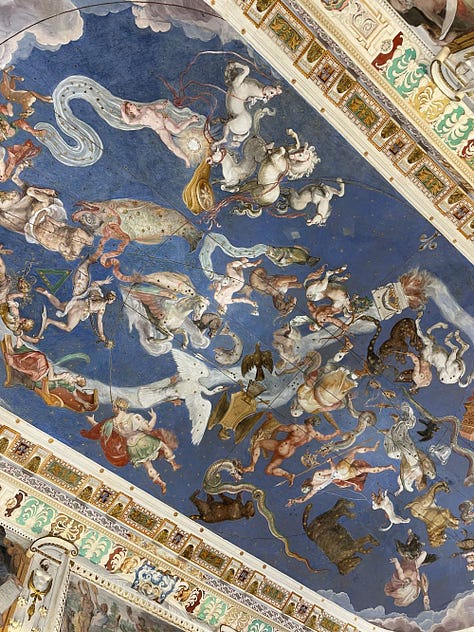
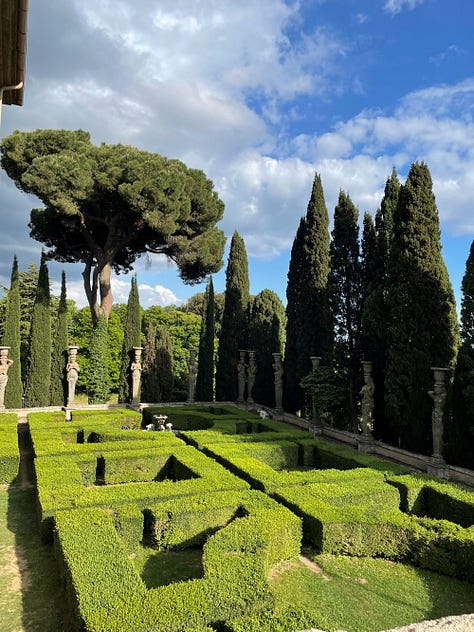
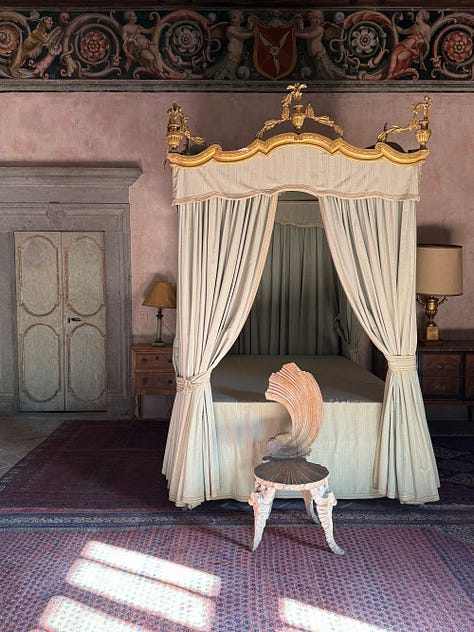
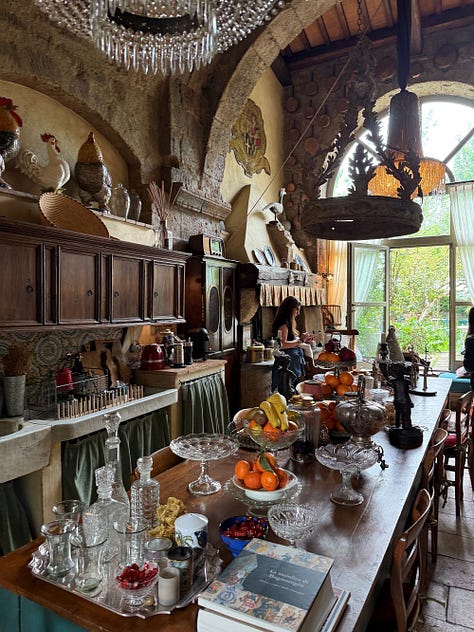
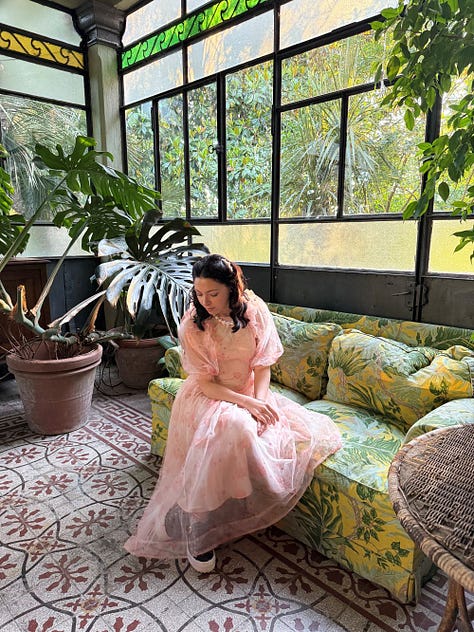
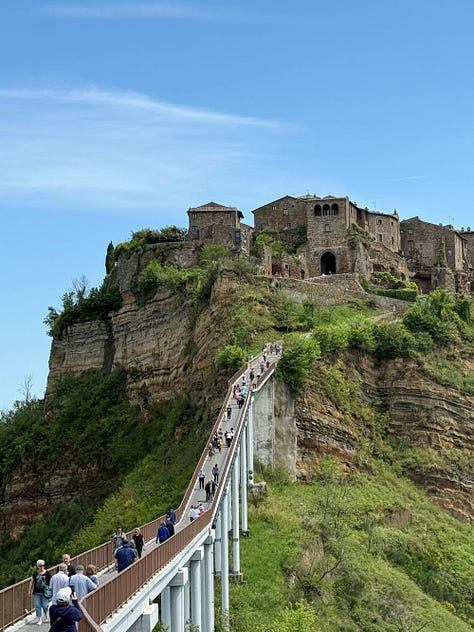

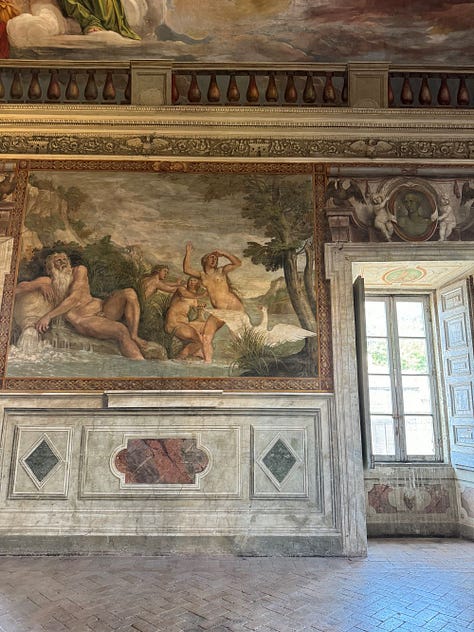
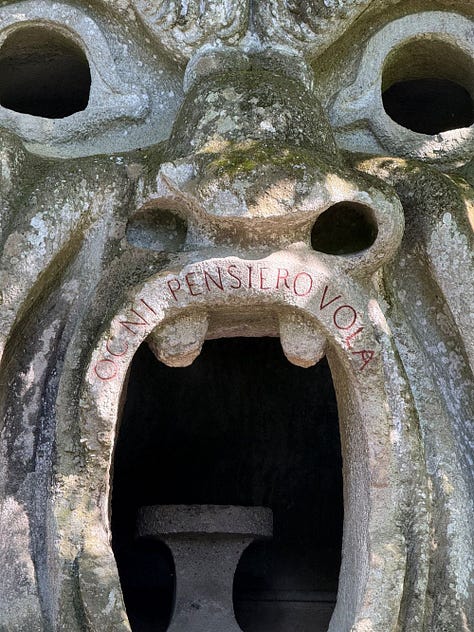
BUY MY EBOOKS
(italian & english)
